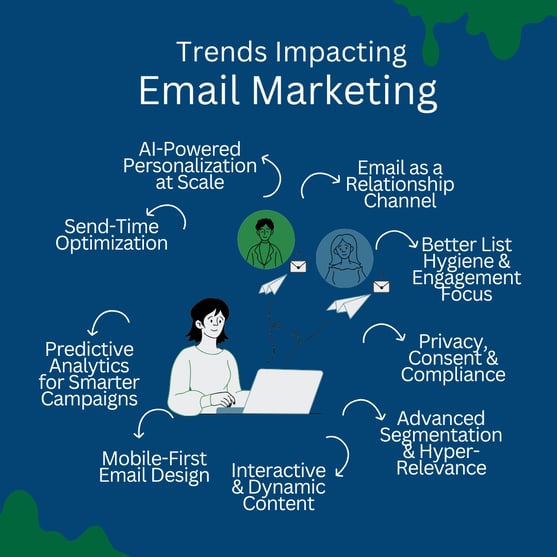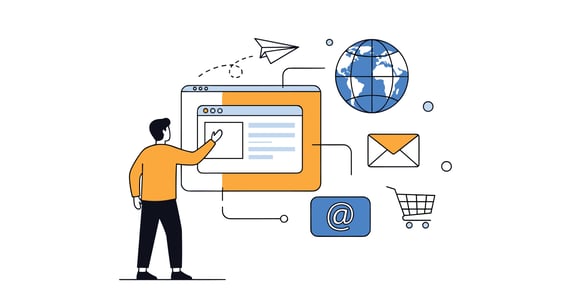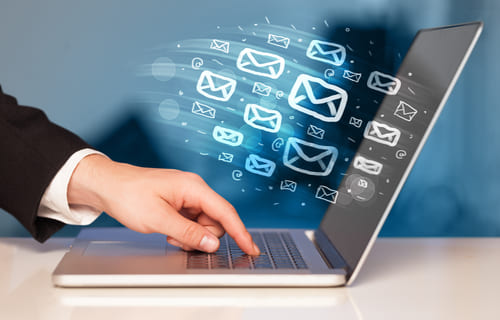Editor's Note: This post was initially published in April 2021 and was updated with additional content in October 2024.
|
What You’ll Learn:
|
Is email marketing still relevant today, or has the allure worn off?
Gary Thuerk, an employee of Digital Equipment Corp, sent the first email marketing blast in 1978. He sent an email promoting his company’s computers to 400 recipients, and it netted $13 million in sales—about $78.8 million today.
Even today, well-crafted, targeted, and meaningful emails can be one of the most effective marketing methods for connecting with your audience at every stage of the buyer's journey.
|
Email has been driving ROI since 1978—and it’s only gotten smarter with AI. |
Benefits of Email Marketing
While email marketing may conjure memories of the last spammy message you received, a customer-centric email spurs action from your leads. If you want to nurture customer relationships and increase profits, a nuanced email marketing campaign ticks all the boxes:
- It’s still one of the most widely used forms of digital communication As of November 2023, stats show that 92.4% of internet users in the United States use email. Both B2B and B2C businesses regard email as one of the most reliable methods to promote content marketing.
- Cost-effective. There is minimal outlay, but an ROI of $36 is generated for every $1 spent.
- Mobile-friendly. Around two-thirds of emails are read on mobile. Get in front of the right customers at the right time using mobile-first design.
- Automatable. Email automation ensures that each recipient gets the correct email at the right time, depending on where in the customer journey they are.
- Personalization. Email marketing software makes sending different messages to each audience segment easy.
| For every $1 spent on email marketing, businesses see an average return of $36. |
Some of the Benefits of AI For Email Marketing
- Personalization: AI enables highly personalized email content by analyzing user behavior, preferences, and interactions.
- Segmentation: AI-driven segmentation goes beyond basic demographic data, allowing dynamic and behavior-based segments to be updated in real time and ensuring the right message reaches the right audience.
- Optimized send-out times: AI can analyze user data to determine the best times to send emails to each recipient, increasing the likelihood of opens and engagements. This optimization can lead to significant improvements in open and click-through rates.
- Enhanced A/B testing: AI can automate and accelerate the A/B testing process by quickly analyzing the performance of different email elements, such as subject lines, content, and images. It can then suggest the most effective variations, saving time and resources.
- Predictive analytics: Predictive AI-powered models can forecast campaign outcomes by analyzing historical data and identifying patterns. This helps marketers to set realistic goals, allocate resources efficiently, and tweak strategies for better performance.
- Improved content creation: AI tools can assist in generating compelling subject lines, email copy, and even design elements. These tools use natural language processing and machine learning to create content that resonates with the audience while maintaining brand voice.
What Trends Are Impacting Email Marketing?
Here are the most impactful trends to watch:

AI-Powered Personalization at Scale
Advanced AI tools are allowing businesses to send content that’s not just personalized—but behavior-driven and dynamically generated. AI can analyze how recipients interact with emails and adjust content, send times, and frequency based on real-time data.
Send-Time Optimization
Gone are the days of “Tuesday at 10 a.m.” as a one-size-fits-all rule. AI-powered platforms now determine the best time to send emails to each individual based on their engagement habits—maximizing visibility and response.
Predictive Analytics for Smarter Campaigns
AI is also being used to forecast engagement, conversions, and customer behavior before a campaign is even launched. These insights help marketers set smarter goals and allocate resources more efficiently.
Mobile-First Email Design
With over 70% of emails being read on mobile devices, responsive design is non-negotiable. Mobile-first formatting, simplified layouts, and concise copy are critical to retaining attention and driving action on smaller screens.
Interactive & Dynamic Content
Interactive elements—such as polls, carousels, and embedded videos—are being used to boost engagement without requiring the reader to leave the inbox. Dynamic content blocks that change based on the recipient’s data are also more common.
Advanced Segmentation & Hyper-Relevance
Segmentation has moved beyond basic demographics. Today’s tools enable segmentation based on real-time behavior, purchase history, and engagement levels—ensuring every message feels personally relevant.
Privacy, Consent & Compliance
Consumers expect transparency and control over their data. Staying compliant with laws like GDPR, CAN-SPAM, and CASL is not just a legal requirement—it’s also key to maintaining trust and email deliverability.
Better List Hygiene & Engagement Focus
Quality matters more than quantity. Brands are focusing on list quality—removing inactive contacts, reducing bounce rates, and running re-engagement campaigns to maintain healthy engagement metrics.
Email as a Relationship Channel
More brands are using email as a long-term engagement channel rather than just a sales tool. Welcome sequences, onboarding flows, and content-driven emails help nurture subscribers into loyal customers.
| The future of email isn’t more messages—it’s more relevance. |
Email Marketing Strategy for Your Business
- Comply with relevant anti-spam and protection of privacy regulations:
- United States: CAN-SPAM Act
- Canada: CASL
- European Union: GDPR
- Australia: Spam Act 2003
- Grow a high-quality email list using a sign-up form that requires subscribers to opt in.
- Segment your email list by organizing it into groups (age, gender, preferences, geographic location) so that the messages are personalized, making the recipients feel special and understood.
- Personalize your emails to deliver hyper-relevant content to your customers and increase the chances of having them opened by 26%. Try including their name in the subject line and send your emails based on your subscribers’ time zones.
- Produce dynamic content that has your readers wanting more! Include an attention-grabbing subject line that entices them to open your mail. Double-check every detail of your email to ensure it is flawless before you hit send.
- Automate to send a series of highly targeted emails that are triggered by the actions of a subscriber. Maximum excitement and momentum for minimum effort.
- Test and measure. You can use analytics to measure the success of your email marketing efforts according to open rates, engagement, and lead generation. Use this insight to improve future campaigns and customer engagement.
- A/B testing, on the other hand, compares different versions of a single email to measure the impact of minor changes.
| Successful email marketing isn’t about volume—it’s about value. |
Does Email Marketing Still Work?
Proof that email is far from dead: “Despite the growth and prominence of mobile messengers and chat apps, email is an integral part of daily online life. In 2025, the number of global e-mail users amounted to 4.48 billion and is projected to grow to 4.85 billion in 2027.
How to Measure the Success of Email Marketing
Measuring the success of your email marketing efforts is essential to understanding what works, what needs improvement, and how your campaigns contribute to your broader business goals. By tracking the right metrics, you can make informed decisions, adjust your strategy, and increase your return on investment over time.

Here are the key performance indicators (KPIs) you should be tracking:
Open Rate
This shows how many recipients opened your email. While it's influenced by subject lines and timing, it also helps you gauge whether your audience finds your emails worth opening.
Click Through Rates (CTR)
Your CTR tells you how many people clicked on links within your email. It's one of the most important metrics for understanding how effective your content and calls-to-action are. A low CTR might indicate that you need to focus on creating relevant content or adjusting your CTA placement.
Conversion Rate
This is the percentage of email recipients who completed a desired action—such as filling out a form, downloading a resource, or making a purchase—after clicking through. It reflects the real impact of your email efforts.
Unsubscribe Rate
A small number of unsubscribes is normal, but a spike could be a sign that your content isn't aligning with audience expectations or you're sending it too frequently.
Bounce Rate
Bounces occur when your emails can't be delivered. A high bounce rate might signal issues with your list hygiene or the quality of your email service provider.
List Growth Rate
Track how quickly your subscriber list is growing (or shrinking). Healthy list growth indicates that your lead generation efforts and campaigns are a great way to expand your reach.
Split Testing Results

Run A/B tests on subject lines, content, layout, and CTAs—changing one element at a time—to understand what resonates with your audience. Testing helps refine your approach and ensures every message is more effective than the last.
Overall Email Performance Trends
Look beyond single campaigns. Evaluating your overall email performance across multiple campaigns and newsletters gives you a clearer view of long-term engagement and progress.
| Email remains a channel you own—making it one of the most reliable tools in digital marketing. |
How to Do Email Marketing Successfully
Is email marketing still relevant? Yes! Talk to us to create a strategy and to learn about the effectiveness of email marketing.
|
FAQs 1. Is email marketing still worth investing in? Absolutely. Email marketing continues to deliver one of the highest returns on investment compared to other digital marketing channels. It’s measurable, personal, and adaptable—making it a core component of both B2B and B2C marketing strategies. 2. How is AI changing email marketing today? AI makes it easier to send the right message to the right person at the right time. It powers segmentation, predicts user behavior, automates content creation, and optimizes subject lines and send times. The result? More relevant emails, better engagement, and improved results without extra manual effort. 3. Isn’t email marketing just spam? Not when done correctly. Modern email marketing focuses on creating relevant content, personalization, and consent-based outreach. When you use data to send helpful, well-timed emails to people who have opted in, email becomes a trusted and effective communication tool—not spam. 4. What are some common mistakes businesses make with email marketing?
Avoiding these mistakes can significantly increase engagement and performance. 5. How often should I email my subscribers? It depends on your industry and audience, but consistency matters more than frequency. For many businesses, one to four emails per month is a good starting point. Monitor engagement and adjust based on feedback and data. 6. What’s the best way to grow my email list? Offer something of value in exchange for a user’s email address—like a free resource, discount, or webinar. Use sign-up forms, pop-ups (used sparingly), gated content, and social promotions. Always make sure you're using a clear, permission-based opt-in process. 7. What’s more important: design or content? Both matter. Clean, mobile-responsive design ensures your email is easy to read and looks professional. Strong content is what drives clicks and conversions. A good email service will help you optimize both the design and delivery of your emails. 8. Can email marketing be automated without losing the personal touch? Yes. With the right email service provider and strategy, you can automate emails that still feel personal. Welcome sequences, follow-ups, abandoned cart reminders, and re-engagement campaigns can all be highly personalized using automation and dynamic content. 9. How do I know if my email marketing is working? You’ll want to track metrics like open rates, click-through rates, conversion rates, unsubscribe rates, and bounce rates. Evaluating these KPIs regularly—and running split tests—can show you what’s working and where to improve. 10. What’s the future of email marketing? Email marketing will continue evolving with technology—especially AI. We expect even greater personalization, smarter automation, real-time dynamic content, and deeper integration with other digital tools. But the core principle will remain: deliver value through meaningful communication. |


